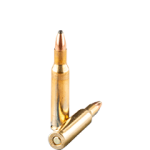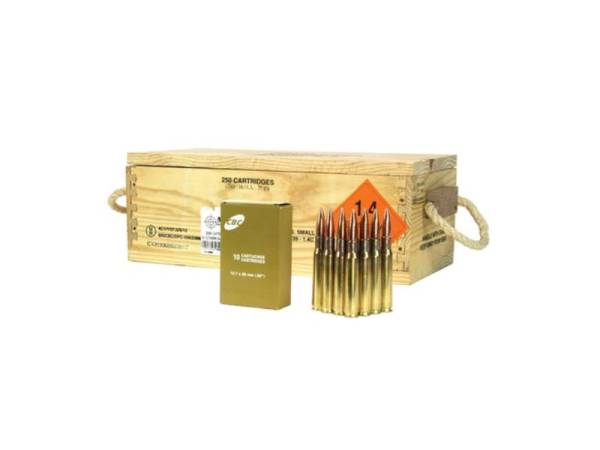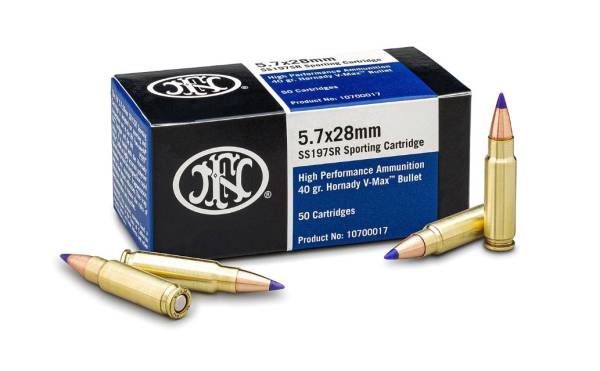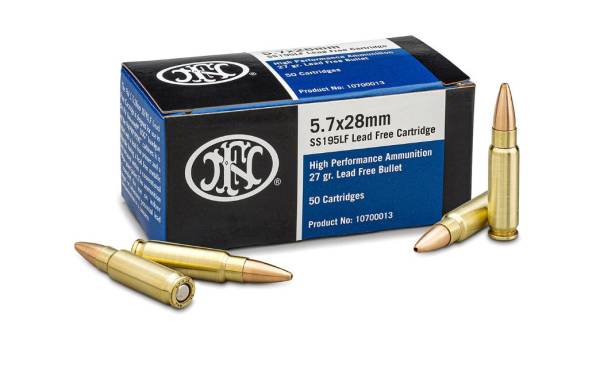Description
One of the most popular rifle cartridges in the United States, the .223 Remington is a favorite among hunters, target shooters, and backyard plinkers alike.
Standard .223 ammunition features a .224-inch diameter boat tailed bullet that sits in a rimless, bottleneck case that measures 1.76 inches in length. The overall length of the cartridge reaches 2.26 inches.
Standard factory loads of .223 Remington ammo range in weight from 35 to 85 grain (gr), but the most common, by far, is the 55 gr bullet. For those who reload their own ammunition, 90 to 95 gr projectiles offer even more versatility to the round.
This popular cartridge uses a small rifle primer and has a maximum pressure of 55,000 pounds per square inch (psi). The rifling twist for traditional bolt action .233 rifles is 1:12 inch, while military-style AR-15 semi-automatics are found with a twist between 1:7 and 1:10 inch. This tighter rifling stabilizes the projectile and improves its accuracy.
The Development of .223 Remington Ammo
According to Cartridges of the World, the .223 Rem was born out of an experimental military cartridge designed at the request of the U.S. military for what would eventually become the ArmaLite AR-15 – one of the guns often referred to as an “assault rifle” by gun control advocates.
The 1950s saw many innovations and breakthroughs in lightweight military rifles, and the American military was looking for an upgrade. In 1955, Eugene Stoner, the chief engineer for ArmaLite, completed his design for the ArmaLite AR-10, the first lightweight select-fire infantry rifle. The AR-10 was chambered to the 7.62x51mm NATO (not the same as, but very similar to, the .308 Winchester).
The Army rejected the AR-10 (most likely because it came late into the testing cycle, not because of any defect in its craftsmanship or performance), instead opting for the M14. Yet in 1957, the United States Continental Army Command (CONARC) requested a smaller version of the AR-10 – they wanted a lightweight rifle that could handle a variation of .22 caliber ammunition.
CONARC set specific requirements for the caliber and rifle they wanted. It must:
Have a .22 caliber bullet
Exceed supersonic speed at a distance of 500 yards
Weigh no more than six pounds
Hold at least 20 rounds
Offer select fire for semi-automatic and fully-automatic
Penetrate a U.S. steel helmet at 500 yards
Penetrate a .135-inch steel plate at 500 yards
Reach the accuracy and ballistic power of the .30-06 M1 Garand
Be equal to or exceed the wounding ability of the M1
Stoner presented the preliminary AR-15 prototype in 1957, and completed a live fire demonstration for then Commanding General of CONARC, General Willard Wyman. The General liked what he saw and proceeded with an order for test rifles.
The beginning stages of the ammunition creation started with Earle Harvey, of Springfield Armory. He took the standard .222 Remington and slightly lengthened it to allow for more powder, calling the round the .224 Springfield. But shortly into his work, he was ordered to stop pursuing the new .22 cartridge, as Springfield Armory was working on a 7.62mm chambered rifle and didn’t want two competing firearms.
Stoner then enlisted the help of Sierra Bullet’s Frank Snow, and together they determined the ballistic needs to meet CONARC’s requirements. For the projectile to still have supersonic speed (1,080 feet per second – fps – at sea level) at 500 yards, they would need a 55 gr bullet to reach a muzzle velocity of 3,300 fps.
Robert Hutton, then technical editor of Guns & AmmoMagazine, assisted by working on the development of a powder load that could get that size projectile traveling that quickly.
In May of 1959, the first reports of initial AR-15 testing showed that five-to-seven men squads with AR-15s had higher hit probability than 11-man squads with the M-14. That same summer, U.S. Air Force General, Curtis LeMay, test fired the AR-15 and liked it so much that he ordered a number of guns to replace the M2 carbines currently being used by the Air Force. In November, the AR-15 was approved for Air Force trials with its minimal 2.5 out of 1,000 failure rate.
In 1961, marksmanship testing showed that 43 percent of shooters using the AR-15 achieved “Expert” status, while only 22 percent of those with the M-14 reached the same certification. General LeMay ordered 80,000 of the ArmaLite lightweight rifles.
By early 1962, the specifications of the .223 Remington were turned into the Sporting Arms and Ammunition Manufacturers’ Institute (SAAMI). In July of that same year, operational testing officially ended as SAAMI recommended proceeding with the AR-15 and the .223 Remington.
In 1964, the U.S. Army officially adopted the .223 Remington in the form of 5.56mm ball cartridge M193, which would eventually become known as the 5.56x45mm NATO. This ammunition was used in the Army’s new M-16 rifles and these firearms were quickly put to work during the Vietnam War, where they proved their effectiveness and deadliness.
That same year, shortly after adoption by the Army, Remington Arms released the first commercial civilian .223 Rem sporting rifle, the Remington 760.
It didn’t take long for the .223 to become more popular than the .222 Remington and the Remington Magnum. Still, the AR-15 is the quintessential American rifle, few can arugue that. In today’s market, most manufacturers of long guns make at least one variation chambered in the .223 Rem. Shooters can often be found with both bolt-action rifles and AR-style semi-automatics in the .223.
223 Defense Ammo and Hunting Ammo
With its mild recoil, the .223 Remington became popular across many different shooting applications and firearm disciplines, with hunters of varmints and predators as the primary buyers. Its success is based on being faster than the .222 Remington, but not quite as fast as the .22-50, a perfect place for a good varmint gun to be.
The flat trajectory and reliable accuracy of the cartridge were appreciated by hunters who used it effectively against small vermin and medium-size predators like coyotes, up to a distance of 300 yards.
At the birth of the .223 Remington and for the next 35 years, the round was not considered safe for hunting whitetail deer. Some jurisdictions even outlawed using the ammunition during rifle season – as it was deemed that the bullet diameter and muzzle energy were insufficient for humane harvesting.
Perhaps, at the time, they were. But with today’s modern ballistic and ammunition technology, .223 rifle ammo is acceptable in most parts of the country for close-range (around 100 yards or so) whitetail hunting. According to American Hunter, hunters should opt for a long gun with a rifling twist rate of 1:8 inch or 1:10 inch to ensure stopping power and lethality.
Beyond hunting, the .223 Remington is popular with competitive shooters since it can be fired in Service Rifle and F-Class matches. In these matches, the contest involves shooting at ranges as great as 1,000 yards. Three-gun shooters have made the .223 popular in competitions, mostly due to its mild recoil, light weight, and high-capacity magazines that allow it to be fired quickly and precisely.
The round is also popular among new shooters, and is often used as a groundbreaking gun for rifling and centerfire rounds. New shooters are able to handle the firearm with ease and the recoil is manageable even for young shooters.
Many law enforcement agencies have added the .223 Remington to their cache of firearms. It rides along in patrol cars, sometimes replacing a 12 gauge shotgun when longer shots or more precision is necessary. Beyond patrol duties, some departments employ the cartridge in urban sniping operations, as well.
223 Bulk Ammo: The Perks of Cheap .223 Ammo
The .223 has become one of the most purchased cartridges in the U.S., which is why firearms manufacturers regularly expand and refine the products they have chambered for this round. This popularity is why bulk .223 ammo is so commonly found, allowing shooters to purchase large quantities of .223 ammunition.
When it comes to .223 ammo for sale, shooters can find affordable bulk .223 ammo at local gun stores and online. Surplus military ammo is also easy to find and offers cheap .223 ammunition.
Depending on the shooter’s specific needs, .223 ammo can be found in a variety of types, by just about all ammunition manufacturers. Federal .223 ammo is a favorite among many shooters and some claim that it’s the best in AR-15 style weapons.
Some of the most common .223 ammo for sale includes:
Full metal jacket (FMJ): FMJ ammo is what many people think of when they picture ammunition; it features a lead bullet, encased in a harder metal jacket, often made of copper.
Jacketed hollow point (JHP): JHP ammo features a similar lead bullet with a copper jacket, but these projectiles have a hollow hole into their center; this hollow point allows for bigger expansion upon impact and is often seen in .223 defense ammo and in hunting cartridges.
Hollow point (HP): Hollow point rounds have an uncovered lead bullet that features a hollow tip at the bullet’s nose; like JHP ammo, HP rounds are designed for hunting and defense and, in many cases, have an improved accuracy over solid bullets.
Full metal jacket-boat tail (FMJ-BT): These cartridges have an FMJ bullet that’s roughly shaped like a boat, with a tapered rear. FMJ-BT ammo is often seen in competition shooting, as it can stabilize the flight of the projectile, improving accuracy. These types of bullets can also be seen in hollow point boat tail (HPBT) variations.
Soft point (SP): Soft point ammunition features a bullet that may be encased or jacketed (then called jacketed soft points or JSP), but the nose of the bullet, its tip, is left with exposed lead. SP ammo is used in hunting, especially in areas where hollow points are restricted and it can give the shooter greater penetration and slower expansion.
V-MAX: Designed by Hornady, the V-MAX ammo is designed specifically for varmint control; with its thin jacket and polymer tip, the bullet is designed to fragment on impact, even if it doesn’t reach maximum velocity.
Open Tip Match (OTM): OTM ammo is used specifically for target and competition shooting. With their open tips, these cartridges look like hollow points, but they’re technically not. They’re designed to increase accuracy at the range, but are pretty pointless outside this use, as they don’t do much upon impact.
Fusion: Designed by Federal as their primary deer hunting round, the bullets in Fusion cartridges feature a jacket that’s electro-chemically fused to the projectile’s lead core. This fusion eliminates the risk of early separation and leads to consistent expansion upon impact, even at long distances.
AccuTip-V: Made by Remington as its premier varmint ammunition, these rounds have a polymer tip, thin metal jacket, and swaged lead core, giving the shooter extreme accuracy paired with a flat trajectory and high velocity – which leads to a massive explosive expansion.
When looking for cheap .223 ammo, many shooters opt for steel casings instead of the traditional brass or brass-plated steel.
.223 Rifle Ammo: AR-15 .223 Ammo
No discussion of .223 Remington ammunition would be complete without mentioning the AR-15 style rifles that are so popular with today’s gun enthusiasts. Although it all started with the ArmaLite AR-15, these military-style semi-automatic firearms are now available from a wide range of gun manufacturers.
Some AR-style guns are chambered for .223 Remington ammo while others are chambered for 5.56x45mm NATO. Although these two cartridges look almost identical on the outside, they’re definitely not alike on the inside. They have different powder loads, different bullet weights, and, perhaps most importantly, different chamber pressure. In the simplest of terms, many shooters like to think of the 5.56 as a .223 +P round.
More significant than their internal differences, the rifles these ammunitions are fired from have different barrel configurations. The leade, which is the distance from the seated projectile to where the rifling starts, is shorter for rifles and carbines chambered for the .223 than for the 5.56x45mm NATO.
Because of these differences, the two cartridges are not interchangeable. If shooters attempt to fire a 5.56x45mm round from a rifle chambered for the .223 Remington, the resulting pressures could be dangerously high. According to SAAMI standards, the pressure may exceed the .223 barrel’s capacity and be dangerous to both the firearm and the shooter.
However, .223 ammunition can, most times, be fired in weapons chambered for the 5.56mm without issue.
In more modern firearms, and especially those AR-style rifles, the gun may be chambered for both rounds. If not, in some cases a .223 Wylde can be added to solve this problem. A hybrid .223/5.56 chamber, the .223 Wylde can be added to a .223 Remington rifle to make it safely accept and fire 5.56x45mm ammunition without sacrificing accuracy.
FAQ
What is 223 ammo?
The .223 Remington is a common rifle cartridge that developed alongside the Military’s AR-15. Most commonly found in 55 grain (gr), the .223 Rem cartridge offers shooters a mild recoil and straight trajectory, making it popular as a varmint gun and to harvest small predators, such as coyotes. It’s similar in size to the 5.56×45mm NATO round and .223 ammo can be fired from firearms chambered to the more powerful cartridge, which makes it a favorite among shooters of AR-style guns.
What is the difference between 223 and 5.56 ammo?
Although .223 Remington and 5.56×45mm NATO ammo look nearly identical, they have different configurations. With different powder loads, bullet weights, and chamber pressure, the Military round carries more force and stopping power than .223 ammo and is often thought of as a .223 +P round. What’s more, rifles chambered for .223 ammunition have a shorter leade (distance from where the cartridge sits to where the rifling of the barrel begins) than those chambered for 5.56 NATO ammo.
Due to these differences, these rounds are not interchangeable. In most cases, .223 ammo can be fired out of firearms chambered for the 5.56 NATO, but 5.56 ammo can not be fired from .223 chambered rifles.
What is green tip 223 ammo?
If your .223 ammo has a green tip, chances are it’s military surplus of M855 rounds, also referred to as bulk ammo. These cartridges are often 5.56×45mm NATO rounds and contain a steel bar inside the bullet. When compared to standard full metal jacket (FMJ) ammo, green tip ammo has greater penetration and can even pierce armoured tanks and steel. If your bullet tip is green plastic, not green paint, then it may be a ballistic or polymer tipped specialty bullet, such as Hornady FTX ammo.
What is the best 223 ammo?
The best .223 ammunition depends on the shooter’s needs and expectations. For instance, for those who just shoot at the range, full metal jacket (FMJ) ammo is often the top choice. FMJ cartridges are affordable and can often be found in bulk. For hunting purposes, a hollow point or jacketed hollow point (JHP) bullet offers more stopping power and less penetration. Special hunting rounds are also available, including Hornady’s V-Max and Remington’s AccuTip-V, both designed for varmint hunting, while Federal’s Fusion ammo is designed for deer hunting. For the competition shooter, .223 cartridges in OTM (open tip match) or FMJ-BT (full metal jacket-boat tail) are often the top choices.
What is subsonic 223 ammo?
Subsonic .223 ammo features bullets that travel at speeds slower than 1,126 feet per second, keeping the velocity below the speed of sound. In .223 Remington rounds, this is most often accomplished by increasing the bullet weight from the traditional 55 grain (gr) to a heavier 77 gr. This added weight slows the bullet down, keeping it below the sound barrier threshold. Shooters may opt for the slower ammo to protect their ears, as these rounds are much quieter to shoot without the bang of a sonic boom. Many ammunition companies make subsonic .223 ammo, including Fiocchi, Federal, and Black Hills Ammunitions.
What 223 ammo does the military use?
The US Military uses 5.56×45mm NATO ammunition, which is similar in appearance to the .223 Remington, but has different configurations and is more powerful. The Military has multiple versions of the 5.56 NATO, including the M193 (a 55 grain (gr), full metal jacket-boat tail bullet), M196 (53 gr, tracer bullet with an orange tip), M855 (62 gr, FMJ-BT with a steel core and green tip), and the M856 (60 gr, FMJ tracer bullet). The Military has other configurations as well, including those specially designed for sniper rifles.
What is the difference between 223 and .223 Rem ammo?
Although it’s commonly referred to as 223 ammo, 223 and .223 Rem are the same ammunition cartridge. The official name of the round is .223 Remington and comes from the parent cartridge, the .222 Remington. The numerical aspect of the ammo, the .223, is a measurement of the bullet diameter and represents .223 inch.





